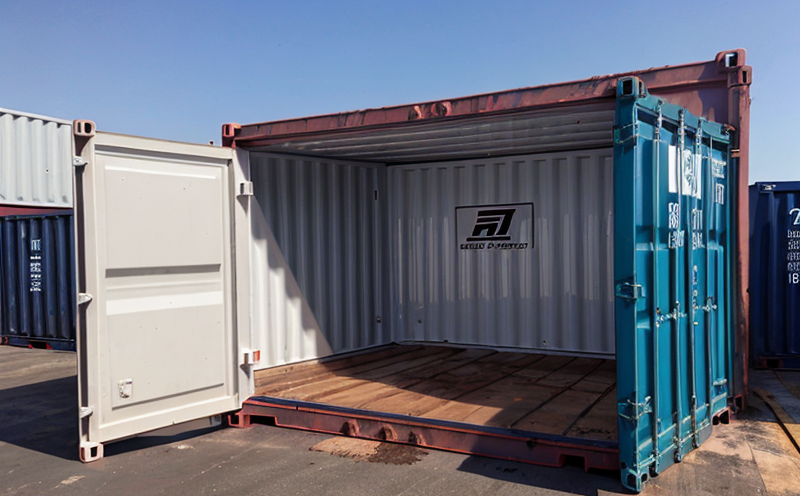ISO tank container inspection
The ISO tank container inspection is a critical component in ensuring the integrity and safety of transportable pressure vessels used in the transportation and logistics sector. These containers are designed to carry hazardous materials, chemicals, and other substances that require strict handling procedures to prevent leaks, spills, or explosions.
ISO 9001:2015 standards emphasize quality management systems which are essential for maintaining high-quality practices during inspection processes. The International Organization for Standardization (ISO) has set guidelines in ISO 6703 and ISO 8406 to ensure the structural integrity of tank containers used in transportation.
The inspection process typically involves several stages including pre-inspection preparation, visual examination, non-destructive testing (NDT), hydrostatic testing, and final documentation. Pre-inspections may include checking for any visible damage or corrosion on the exterior surface. Visual examinations are conducted by trained inspectors who look for cracks, dents, and other signs of wear that could compromise safety.
Non-destructive testing methods such as ultrasonic testing (UT), radiographic examination (RT), and magnetic particle inspection (MPI) are used to detect internal defects without damaging the container. Hydrostatic testing involves filling the tank with water under pressure to check for leaks or structural weaknesses. Once all tests have been completed, a comprehensive report is prepared detailing findings and recommendations.
The importance of adhering to these standards cannot be overstated; they help protect both personnel involved in handling these containers as well as those around them. By ensuring compliance with international regulations like ISO 6703 and ISO 8406, organizations can mitigate risks associated with transporting potentially dangerous materials.
For companies operating within the transportation and logistics industry, investing in regular inspections not only enhances operational efficiency but also contributes towards maintaining a safe working environment. Regular maintenance schedules coupled with thorough testing ensures that these vessels remain fit-for-purpose throughout their lifecycle.
Why Choose This Test
Selecting ISO tank container inspection services is crucial for several reasons. Firstly, it guarantees compliance with international safety standards which are vital in ensuring the transport of hazardous materials is carried out safely and effectively. Secondly, choosing certified laboratories ensures reliability and consistency in results, providing peace of mind to all stakeholders involved.
Thirdly, regular inspections help identify potential issues before they escalate into major problems that could lead to accidents or breaches during transit. Fourthly, adhering to these tests can significantly reduce insurance premiums by demonstrating proactive measures taken towards maintaining vessel integrity.
Fifthly, compliance with ISO standards enhances reputation among clients and partners, showing commitment to best practices in the industry. Lastly, it helps in meeting regulatory requirements imposed by various countries worldwide who regulate transport of dangerous goods via road or rail.
Environmental and Sustainability Contributions
The implementation of ISO tank container inspections plays a significant role in promoting environmental sustainability within transportation and logistics operations. By ensuring that containers are fit-for-purpose, these tests contribute to reducing the risk of spills which can have devastating effects on ecosystems.
In addition to preventing accidents, adhering to rigorous inspection protocols helps extend the useful life span of tank containers, thereby minimizing waste generation associated with premature disposal due to safety concerns. Moreover, by maintaining optimal performance levels through regular maintenance and monitoring, organizations can optimize fuel consumption rates thus reducing carbon footprints linked directly to transportation activities.
The use of non-destructive testing methods also reduces material wastage as it allows for precise identification of defects without necessitating replacement of entire units whenever minor issues are detected. This approach promotes circular economy principles by encouraging reuse and recycling practices within the supply chain network.
Use Cases and Application Examples
- Hazardous Materials Transportation: Ensures that containers used for carrying chemicals, petroleum products, or other hazardous substances meet strict safety requirements before being deployed into service.
- International Trade Compliance: Helps companies comply with regulations set forth by international organizations such as the International Maritime Organization (IMO) and the United Nations' Recommendations on the Transport of Dangerous Goods.
- Internal Audits: Provides detailed reports that can be used during internal audits to assess compliance levels against established protocols and standards.
- New Equipment Evaluation: Allows manufacturers to verify whether newly produced tank containers conform to specified design parameters prior to releasing them into market circulation.
In addition to these specific applications, ISO tank container inspections serve as a cornerstone for ensuring overall safety across various sectors including petrochemicals, pharmaceuticals, food & beverage manufacturing, and chemical processing industries. Their role extends beyond mere compliance; they foster an environment of continuous improvement aimed at enhancing operational excellence throughout the supply chain.





